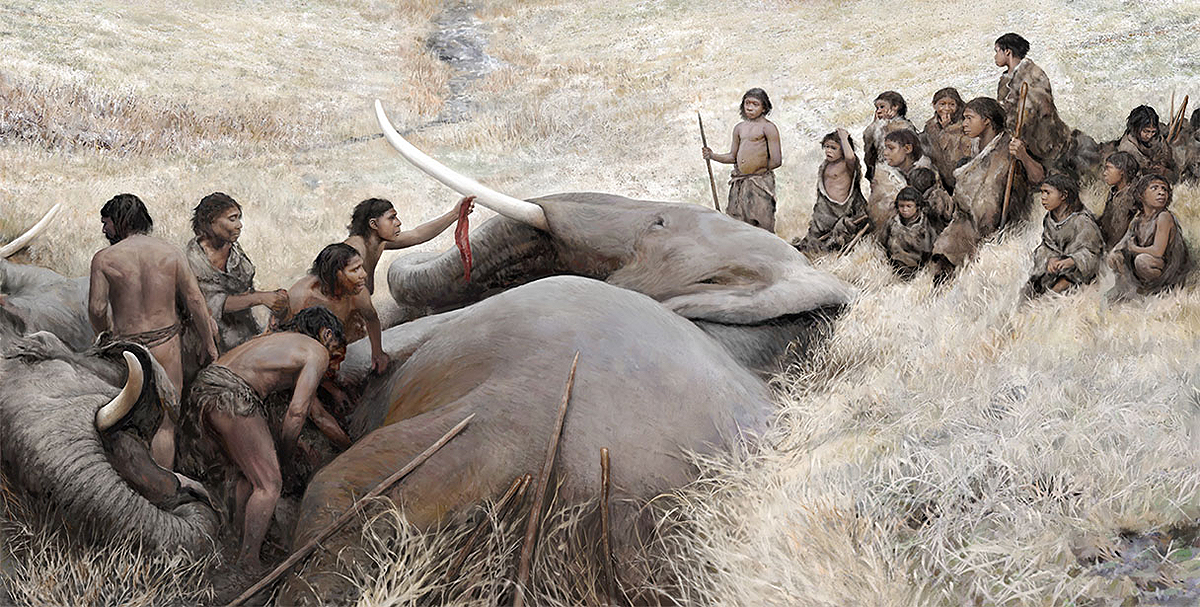


An article on science.org by Andrew Curry - Neanderthals lived in groups big enough to eat giant elephants - reports on a new study relating to the hunting and butchery with stone tools of elephants by Neanderthals in east-central Germany some 125,000 years ago, suggesting a degree of organization with larger social groups than previously thought.

The find comes from a trove of animal bones and stone tools uncovered in the 1980s by coal miners near the town of Neumark-Nord. Beginning in 1985, archaeologists spent a decade observing the mining work, recovering animal bones and stone tools. Dating to a relatively warm period in Europe known as the Eemian interglacial, 75,000 years before modern humans arrived in Western Europe, the discoveries include the bones and tusks of more than 70 mostly adult male straight-tusked elephants (Palaeoloxodon antiquus), an extinct species almost twice the size of modern African elephants that stood nearly 4 meters tall at the shoulder. Most had been left in dozens of piles along the ancient lakeshore over the course of about 300 years.
Lutz Kindler, an archaeozoologist at the MONREPOS Archaeological Research Center, with his colleague Sabine Gaudzinski-Windheuser, also an archaeozoologist at MONREPOS, spent months examining the 3400 elephant bones. Gaudzinski-Windheuser explains that under a microscope nearly every bone showed signs of butchery. Although scientists have long known Neanderthals were capable hunters, these cutmarks “seem to be the first evidence of large-scale elephant hunting,” says April Nowell, an archaeologist at the University of Victoria who was not involved with the research. Gouges and scratches on nearly every bone show the hunters were thorough. “They really went for every scrap of meat and fat,” says University of Leiden archaeologist and study co-author Wil Roebroeks. The bones hadn’t been gnawed by scavengers like wolves or hyenas, suggesting nothing was left for them.
The meat from a single elephant would have been enough to feed 350 people for a week, or 100 people for a month, the researchers calculate. In the past, Neanderthals were thought to live in small, highly mobile groups of about 20 individuals at most, but the elephant bounty suggests far bigger groups - possibly as a large seasonal gathering - once lived near the site, the researchers report today in Science Advances.
by Bradshaw Foundation
Tuesday 21 March 2023
by Bradshaw Foundation
Tuesday 07 February 2023
by Bradshaw Foundation
Thursday 19 May 2022
by Bradshaw Foundation
Tuesday 19 October 2021
by Bradshaw Foundation
Friday 25 June 2021
by Bradshaw Foundation
Monday 09 November 2020
by Bradshaw Foundation
Tuesday 03 November 2020
by Bradshaw Foundation
Wednesday 28 October 2020
by Bradshaw Foundation
Tuesday 23 June 2020
by Bradshaw Foundation
Thursday 04 June 2020
by Bradshaw Foundation
Thursday 14 May 2020
by Bradshaw Foundation
Tuesday 12 May 2020
by Bradshaw Foundation
Wednesday 19 February 2020
by Bradshaw Foundation
Tuesday 21 January 2020
by Bradshaw Foundation
Monday 20 January 2020
by Bradshaw Foundation
Thursday 28 November 2019
by Bradshaw Foundation
Tuesday 21 March 2023
by Bradshaw Foundation
Tuesday 07 February 2023
by Bradshaw Foundation
Thursday 19 May 2022
by Bradshaw Foundation
Tuesday 19 October 2021
by Bradshaw Foundation
Friday 25 June 2021
by Bradshaw Foundation
Monday 09 November 2020
by Bradshaw Foundation
Tuesday 03 November 2020
by Bradshaw Foundation
Wednesday 28 October 2020
by Bradshaw Foundation
Tuesday 23 June 2020
by Bradshaw Foundation
Thursday 04 June 2020
by Bradshaw Foundation
Thursday 14 May 2020
by Bradshaw Foundation
Tuesday 12 May 2020
by Bradshaw Foundation
Wednesday 19 February 2020
by Bradshaw Foundation
Tuesday 21 January 2020
by Bradshaw Foundation
Monday 20 January 2020
by Bradshaw Foundation
Thursday 28 November 2019
Friend of the Foundation











